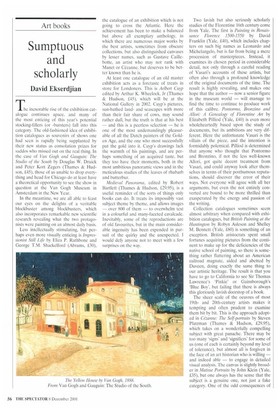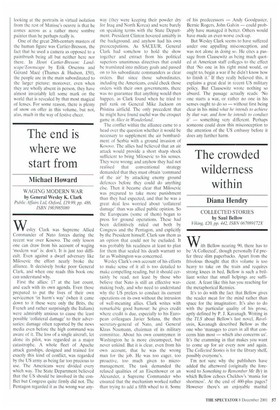Sumptuous and scholarly
David Ekserdjian
he inexorable rise of the exhibition catalogue continues apace, and many of the most enticing of this year's potential stocking-fillers (or -bursters) fall into this category. The old-fashioned idea of exhibition catalogues as souvenirs of shows one had seen is rapidly being supplanted by their new status as consolation prizes for saddos who missed out on the real thing. In the case of Van Gogh and Gauguin: The Studio of the South by Douglas W. Druick and Peter Kort Zegers (Thames & Hudson, £45), those of us unable to drop everything and head for Chicago do at least have a theoretical opportunity to see the show in question at the Van Gogh Museum in Amsterdam in the New Year.
In the meantime, we are all able to feast our eyes on the delights of a veritable blockbuster among blockbusters, which also incorporates remarkable new scientific research revealing what the two protagonists were painting on an almost daily basis.
Less intellectually stimulating, but perhaps even more visually enticing is Impressionist Still Life by Eliza P. Rathbone and George T.M. Shackelford (Abrams, £30),
the catalogue of an exhibition which is not going to cross the Atlantic. Here the achievement has been to make a balanced but above all exemplary anthology, in which there are numerous major works by the best artists, sometimes from obscure collections, but also distinguished canvases by lesser names, such as Gustave Caillebone, an artist who may not rank with Manet or Cezanne, but deserves to be better known than he is.
At least one catalogue of an old master exhibition acts as a foretaste of treats in store for Londoners. This is Aelbert Cuyp edited by Arthur K. Wheelock, Jr (Thames 86 Hudson, £45), which will be at the National Gallery in 2002. Cuyp's pictures, sun-bathed landand seascapes with more than their fair share of cows, may sound rather dull, but the truth is that at his best — and this is a peerless selection — he is one of the most undemandingly pleasurable of all the Dutch painters of the Golden Age, and the one who most successfully put the gold into it. Cuyp's drawings lack the warmth of his paintings, and are perhaps something of an acquired taste, but they too have their moments, both in the most ambitious panoramic views and in the meticulous studies of the leaves of rhubarb and butterbur.
Medieval Panorama, edited by Robert Bartlett (Thames & Hudson, £29.95), is a useful reminder of the sorts of things only books can do. It treats its impossibly vast subject theme by theme, and allows images — over 800 of them — to overwhelm text in a colourful and many-faceted cavalcade. Inevitably, some of the reproductions are of old favourites, but in the main considerable ingenuity has been expended in pursuit of the quirky and the unexpected. I would defy anyone not to meet with a few surprises on the way. Two lavish but also seriously scholarly studies of the Florentine 16th century come from Yale. The first is Painting in Renaissance Florence 1500-1550 by David Franklin (Yale, £40), which includes chapters on such big names as Leonardo and Michelangelo, but is far from being a mere procession of masterpieces. Instead, it examines its chosen period in considerable detail, not only through a careful reading of Vasari's accounts of these artists, but often also through a profound knowledge of the original documents of the time. The result is highly revealing, and makes one hope that the author — now a senior figure in the museum world — will manage to find the time to continue to produce work of this calibre. Pontonno, Bronzino and AIlori: A Genealogy of Florentine Art by Elizabeth Pilliod (Yale, £40) is even more wholeheartedly based upon the study of documents, but its ambitions are very different. Here the unfortunate Vasari is the villain of the piece, and the intention is formidably polemical. Pilliod is determined that anyone who thought that Pontormo and Bronzino, if not the less well-known Allori, got quite decent treatment from Vasari, and could anyway look after themselves in terms of their posthumous reputations, should discover the error of their ways. Not everyone will agree with all her arguments, but even the not entirely converted are bound to be more thrilled than exasperated by the energy and passion of the writing.
Collection catalogues sometimes seem almost arbitrary when compared with exhibition catalogues, but British Painting at the Huntington by Robyn Asleson and Shelley M. Bennett (Yale, £60) is something of an exception. British aristocrats spent small fortunes acquiring pictures from the continent to make up for the deficiencies of the native school of painting, so there is something rather flattering about an American railroad magnate, aided and abetted by Duveen, doing exactly the same thing to our artistic heritage. The result is that you have to go to California to see Sir Thomas Lawrence's 'Pinkie' or Gainsborough's 'Blue Boy', but failing that there is always this gloriously lavish doorstop of a book.
The sheer scale of the oeuvres of most 19thand 20th-century artists makes it tempting and often prudent to examine them bit by bit. This is the approach adopted in Cizanne: The Self-portraits by Steven Platzman (Thames & Hudson, £29.95), which takes on a wonderfully compelling subject with great panache. There may be too many 'signs' and 'signifiers' for some of us (one of each is certainly beyond my level of tolerance), but almost all is forgiven in the face of an art historian who is willing — and indeed able — to engage in detailed visual analysis. The canvas is slightly broader in Matisse Portraits by John Klein (Yale, £35), but one always has the sense that the subject is a genuine one, not just a fake category. One of the odd consequences of looking at the portraits in virtual isolation from the rest of Matisse's oeuvre is that he comes across as a rather more sombre painter than he perhaps really is.
One of the great 20th-century masters of the human figure was Cartier-Bresson, the fact that he used a camera as opposed to a paintbrush being all but neither here nor there. In Henri Cartier-Bresson: Landscape/Townscape by Erik Orsenna and Gerard Mace (Thames Sz Hudson, £50), the people are in the main subordinated to the larger picture; moreover, even when they are wholly absent in person, they have almost invariably left some mark on the world that is revealed by that most magical of lenses. For some reason, there is plenty of snow on offer in this volume, but not, alas. much in the way of festive cheer.























































































 Previous page
Previous page